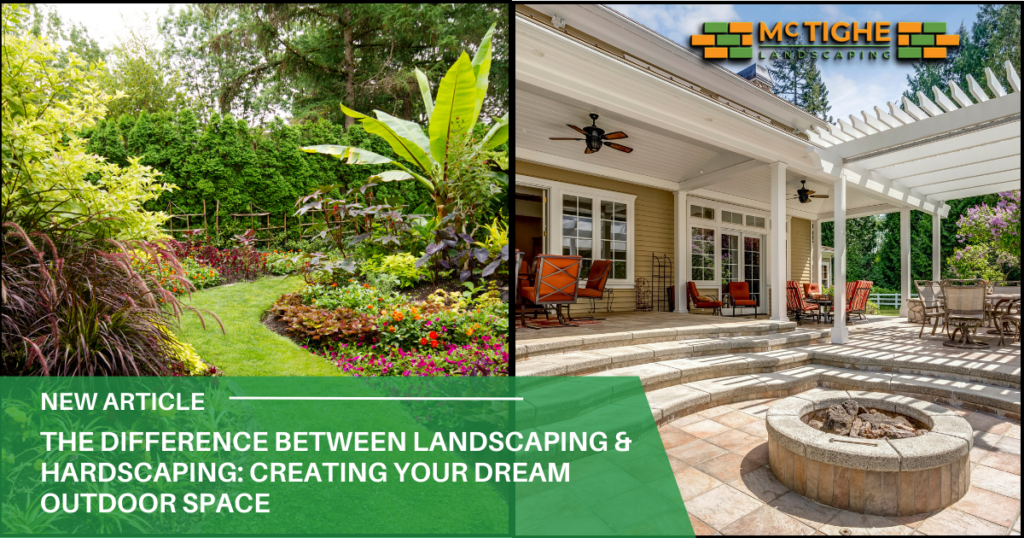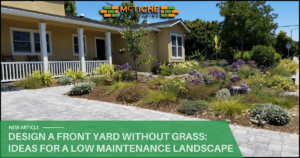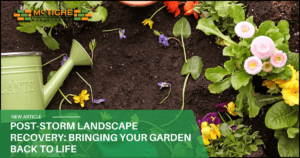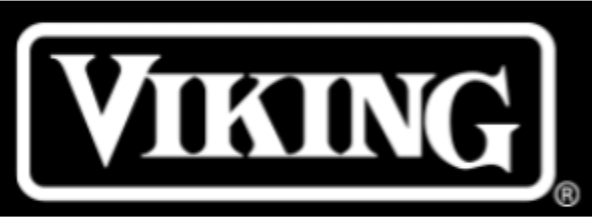Are you dreaming of transforming your outdoor space into a breathtaking oasis? Understanding the difference between landscaping and hardscaping is crucial for creating a balanced and beautiful yard. In this guide, we’ll explore these two essential elements of outdoor design and show you how to make the most of your property. Whether you’re a homeowner in Los Gatos, Sunnyvale, Mountain View, Cupertino, or Saratoga, California, this information will help you create an outdoor living area that perfectly suits your lifestyle and enhances your home’s value.
What is Landscaping?
Landscaping refers to the living, natural elements in your outdoor space. It’s all about working with nature to create a vibrant, dynamic environment that changes with the seasons and grows over time. When done right, landscaping can transform your yard into a lush, inviting retreat that connects you with nature and provides a serene backdrop for outdoor living.
Key Components of Landscaping:
- Trees and shrubs: These form the backbone of your landscape, providing structure, shade, and year-round interest.
- Flower beds and gardens: Add color, fragrance, and texture to your outdoor space, attracting pollinators and creating visual interest.
- Lawns and grass areas: Offer open spaces for recreation and relaxation, while also providing environmental benefits like improved air quality and temperature regulation.
- Natural water features: Ponds, streams, and waterfalls can create a soothing atmosphere and attract wildlife to your yard.
- Ground covers and mulch: Help retain soil moisture, suppress weeds, and add aesthetic appeal to planted areas.
Landscaping brings life, color, and seasonal changes to your yard, creating a lush backdrop for outdoor living. It’s a dynamic aspect of your property that evolves over time, requiring ongoing care and maintenance to look its best.
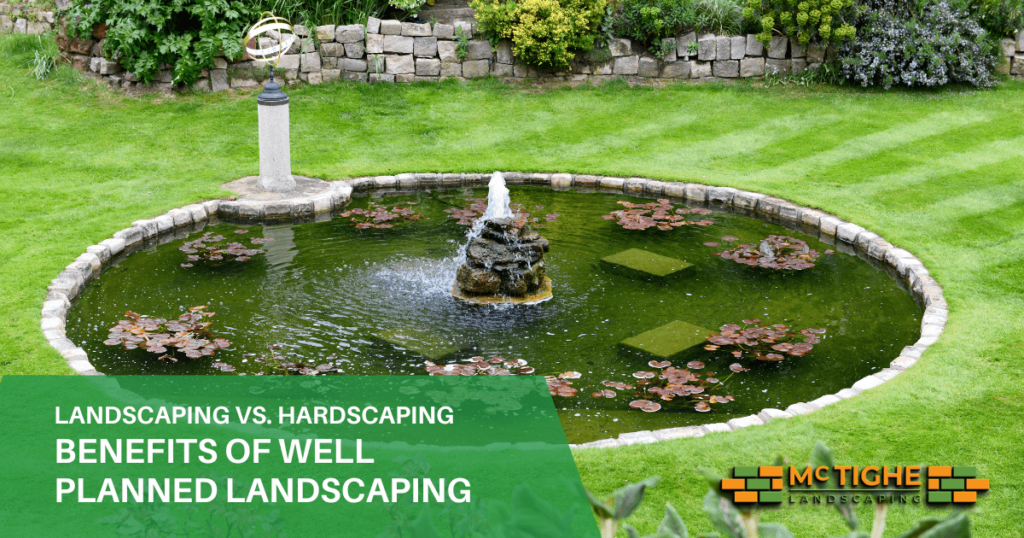
Benefits of Well-Planned Landscaping:
- Increased property value: A beautifully landscaped yard can significantly boost your home’s curb appeal and market value.
- Environmental benefits: Plants and trees improve air quality, reduce erosion, and provide habitats for local wildlife.
- Energy efficiency: Strategically placed trees and shrubs can provide shade and windbreaks, potentially lowering your home’s energy costs.
- Improved mental health: Spending time in green spaces has been shown to reduce stress and improve overall well-being.
- Natural privacy: Dense plantings can create living privacy screens, reducing noise and creating secluded outdoor spaces.
What is Hardscaping?
Hardscaping encompasses the non-living, structural elements of your outdoor design. These features provide functionality, define spaces, and add architectural interest to your property. Hardscaping elements are typically more permanent and require less ongoing maintenance than landscaping, making them an excellent investment in your outdoor living space.
Common Hardscaping Elements
- Patios and decks: Create outdoor living areas for dining, entertaining, or relaxation.
- Walkways and driveways: Improve accessibility and add visual interest to your property.
- Retaining walls: Manage slopes, create terraced gardens, and add vertical interest to your landscape.
- Outdoor kitchens and fireplaces: Extend your living space outdoors and create focal points for gatherings.
- Fences and pergolas: Define boundaries, create privacy, and provide support for climbing plants.
- Man-made water features: Fountains, pools, and spas add luxury and a sense of tranquility to your outdoor space.
Hardscaping adds structure, improves accessibility, and creates usable outdoor living areas. These elements often serve as the foundation for your landscape design, providing a framework around which your plantings can be organized.
Advantages of Incorporating Hardscaping
- Low maintenance: Once installed, hardscaping elements require minimal upkeep compared to living plants.
- Year-round usability: Patios, decks, and other hardscaping features allow you to enjoy your outdoor space regardless of the season.
- Increased property value: Well-designed hardscaping can significantly boost your home’s resale value and appeal to potential buyers.
- Improved drainage: Properly installed hardscaping can help manage water runoff and prevent erosion on your property.
- Defined outdoor rooms: Hardscaping elements help create distinct areas for different activities, maximizing the functionality of your outdoor space.
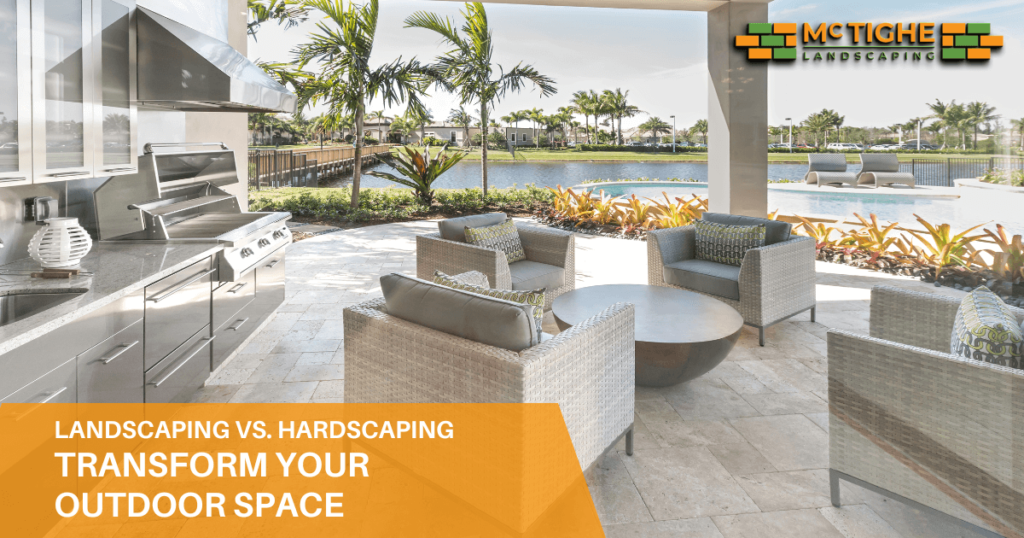
Balancing Landscaping and Hardscaping
The key to a stunning outdoor space lies in finding the perfect balance between soft and hard elements. A well-designed yard seamlessly integrates both landscaping and hardscaping to create a cohesive, functional, and beautiful environment. Here’s how to achieve harmony:
- Plan with purpose: Consider your lifestyle and how you want to use your outdoor space. Do you need a large patio for entertaining, or would you prefer more garden areas for growing vegetables and flowers? Understanding your priorities will help you allocate space and resources appropriately.
- Create contrast: Use hardscaping to define areas and landscaping to soften edges. For example, a straight-lined paver pathway can be softened with ornamental grasses or flowering perennials along its borders.
- Consider maintenance: Balance high-maintenance plantings with low-maintenance hardscapes. If you love gardening, you might opt for more elaborate landscaping. If you prefer a low-maintenance yard, you might lean towards more hardscaping elements with strategically placed, easy-care plants.
- Think long-term: Plan for growth and changes in your landscape over time. Consider how trees and shrubs will mature and how your needs might evolve in the coming years.
- Incorporate transitions: Use elements like stepping stones or ground covers to create smooth transitions between hardscaped and landscaped areas.
- Mind the scale: Ensure that your hardscaping elements are proportionate to your home and lot size. Oversized patios or tiny plant beds can look out of place and disrupt the overall harmony of your outdoor space.
- Consider color and texture: Use the colors and textures of both your hardscaping materials and plant choices to create a cohesive look throughout your yard.
- Embrace curves: While straight lines are often associated with hardscaping, incorporating curved elements can help soften the overall look and create a more natural feel.
By carefully considering these factors, you can create an outdoor space that not only looks beautiful but also functions perfectly for your lifestyle.
Choosing the Right Elements for Your Space
When deciding between landscaping and hardscaping elements, consider these factors to ensure your outdoor space is both beautiful and practical:
- Climate and environment: Choose plants and materials suited to your local conditions. In the Bay Area, this might mean selecting drought-tolerant plants and materials that can withstand occasional heavy rains.
- Native plants: Consider incorporating California natives like Ceanothus, Manzanita, or California Poppy, which are adapted to local conditions and require less water and maintenance.
- Climate-appropriate hardscaping: Use materials that can withstand local weather patterns, such as permeable pavers to manage rainwater runoff.
- Property size and layout: Scale your design to fit your available space.
- Small yards: Focus on vertical elements like living walls or tall planters to maximize space.
- Large properties: Create distinct outdoor rooms using a combination of hardscaping and landscaping elements.
- Budget: Balance cost-intensive hardscaping with more affordable landscaping options.
- Cost-effective landscaping: Start with smaller plants that will grow over time, and use mulch to reduce water needs and suppress weeds.
- Investment hardscaping: Prioritize high-impact hardscaping elements like a patio or retaining wall, which can provide immediate functionality and value.
- Personal style: Reflect your taste through plant choices and hardscape materials.
- Modern aesthetic: Combine clean-lined hardscaping with architectural plants like succulents or ornamental grasses.
- Traditional look: Opt for classic hardscaping materials like brick or natural stone, paired with lush, layered plantings.
- Functionality: Consider how you want to use your outdoor space.
- Entertaining areas: Prioritize hardscaping elements like patios, outdoor kitchens, and built-in seating.
- Relaxation zones: Create secluded garden nooks with a balance of soft landscaping and comfortable hardscaped seating areas.
- Maintenance requirements: Be honest about how much time you’re willing to devote to yard upkeep.
- Low-maintenance options: Consider xeriscaping principles, using native plants and hardscaping elements that require minimal care.
- High-maintenance features: If you enjoy gardening, plan for more intricate landscaping elements like vegetable gardens or formal hedges.
- Water usage: In drought-prone areas like California, water conservation should be a top priority.
- Water-wise landscaping: Incorporate drought-tolerant plants, efficient irrigation systems, and rainwater harvesting techniques.
- Permeable hardscaping: Use materials like permeable pavers or gravel to allow water to percolate into the ground, reducing runoff.
- Lighting considerations: Integrate both landscape and hardscape lighting to extend the usability of your outdoor space into the evening hours.
- Landscape lighting: Highlight key plants or trees with uplighting or moonlighting techniques.
- Hardscape lighting: Incorporate built-in lighting in steps, walls, or under countertops for safety and ambiance.
By carefully considering these factors, you can create an outdoor space that not only looks beautiful but also functions perfectly for your lifestyle and local environment.
Benefits of Professional Design
While DIY projects can be rewarding, working with a professional landscape designer offers several advantages that can save you time, money, and potential headaches in the long run:
- Expert knowledge of local plants and materials
Professional designers have in-depth knowledge of which plants thrive in your specific microclimate. They can recommend the best hardscaping materials for your area’s weather conditions and your home’s architectural style.
- Access to specialized equipment and resources
Landscape professionals have the tools and expertise to handle complex installations efficiently. They often have relationships with suppliers, potentially giving you access to a wider range of materials and plants.
- Time and cost savings through efficient planning and execution
A well-planned design can be implemented more quickly and with fewer costly mistakes. Professionals can help you avoid common pitfalls that might lead to expensive replacements or repairs down the line.
- Cohesive design that maximizes your property’s potential
Designers can create a comprehensive plan that considers both immediate needs and future growth. They can help you balance aesthetics with practical considerations like drainage, sun exposure, and traffic flow.
- Compliance with local regulations
Professional designers are familiar with local zoning laws, building codes, and homeowners’ association rules. They can ensure your project meets all necessary requirements, avoiding potential legal issues.
- Increased property value
A professionally designed landscape can significantly boost your home’s curb appeal and market value. Well-planned outdoor spaces can be a major selling point if you decide to put your home on the market.
- Sustainable design practices
Landscape professionals can incorporate eco-friendly design elements that conserve water and energy. They can suggest native plants and sustainable hardscaping materials that benefit the local ecosystem.
- Custom solutions for challenging spaces
Designers can provide creative solutions for difficult areas like steep slopes, shady corners, or small urban lots. They can help you make the most of your unique property features, turning potential problems into design opportunities.
- Long-term maintenance planning
A professional can create a landscape that not only looks great now but is also manageable in the long term. They can provide guidance on ongoing care and maintenance to keep your outdoor space looking its best year after year.
- 3D visualization and planning
Many designers use advanced software to create 3D renderings of your proposed landscape. This allows you to visualize the final result and make informed decisions before any work begins.
By leveraging the expertise of a professional landscape designer, you can create an outdoor space that is not only beautiful and functional but also tailored specifically to your property, lifestyle, and local environment. This investment in professional design can pay dividends in both enjoyment and property value for years to come.

5 Landscaping and Hardscaping Tips
Tip #1. Landscaping and Hardscaping Cost Varies
Tip #2. Options for Low-Maintenance Hardscaping
Tip #3. How Often You Should Update Your Landscaping
Tip #4. Drainage Issues and Hardscaping
Tip #5. Incorporating Both Landscaping and Hardscaping in a Small Yard
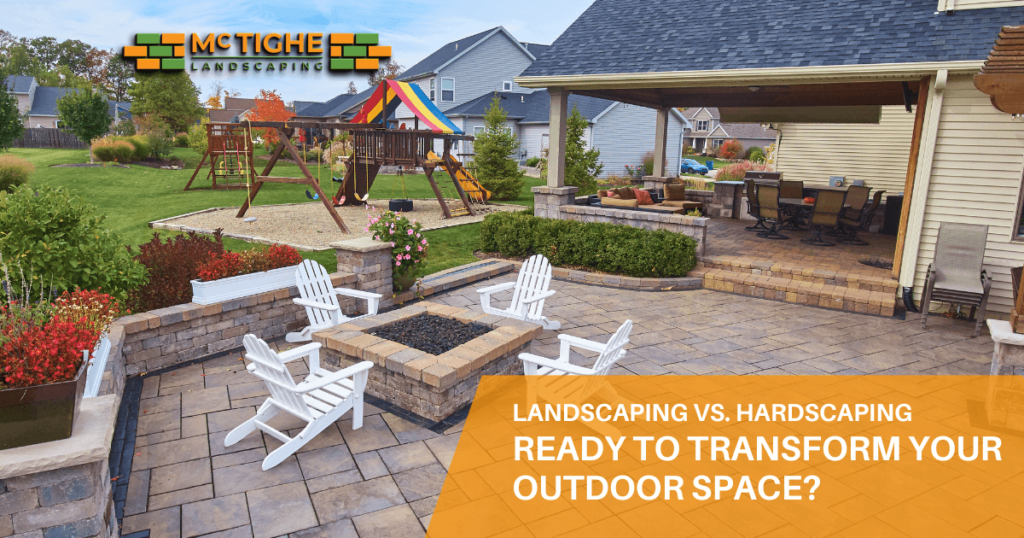
Conclusion: Ready to Transform Your Outdoor Space?
Now that you have a clear understanding of the difference between landscaping and hardscaping, as well as insights into how to balance these elements effectively, you’re well-equipped to start planning your dream outdoor space. Remember, creating a beautiful and functional yard is about more than just placing plants and patios – it’s about crafting an environment that enhances your lifestyle, increases your property value, and provides a personal retreat right outside your door.
Whether you’re looking to create a lush garden oasis, a modern entertaining space, or a low-maintenance yard that still packs a visual punch, the key lies in thoughtfully combining landscaping and hardscaping elements. By considering factors like your local climate, personal style, and long-term maintenance needs, you can design an outdoor area that not only looks stunning but also stands the test of time.
Don’t let another season pass without making the most of your property. Whether you’re in Los Gatos, Sunnyvale, Mountain View, Cupertino, or Saratoga, California, our team of expert landscape designers, landscapers, and hardscapers are ready to bring your vision to life. We understand the unique challenges and opportunities presented by the Bay Area’s climate and lifestyle, and we’re committed to creating outdoor spaces that are both beautiful and sustainable.
Take the Next Step Towards Your Dream Outdoor Space
Ready to start your landscaping and hardscaping journey? Here’s how you can get started:
- Assess your current outdoor space: Take note of what you like, what you’d like to change, and any specific challenges your property presents.
- Define your goals: Consider how you want to use your outdoor space. Do you dream of a tranquil garden retreat, a vibrant entertaining area, or a low-maintenance yard?
- Set a budget: Determine how much you’re willing to invest in your outdoor transformation.
- Gather inspiration: Browse magazines, websites, and social media for ideas that resonate with your vision.
- Contact McTighe Landscaping: Let our experienced team guide you through the design and implementation process.
Don’t let another beautiful Bay Area day go by without enjoying the outdoor space you deserve. Contact McTighe Landscaping today and let’s start creating your perfect balance of landscaping and hardscaping!
Call McTighe Landscaping at (669) 232-8050
Alternatively, you may let us know what project you have in mind by filling out the information in this form.
Let’s work together to balance the perfect blend of landscaping and hardscaping for your unique outdoor space! We serve the following areas: Los Gatos, Sunnyvale, Mountain View, Cupertino, and Saratoga, California.
Remember, your dream outdoor space is just a phone call away. Our team of experts is ready to listen to your ideas, address your concerns, and create a custom design that brings your vision to life. Whether you’re starting from scratch or looking to refresh your existing landscape, we have the skills, knowledge, and creativity to exceed your expectations.
Frequently Asked Questions Our Other Readers Found Helpful
Landscaping costs vary widely depending on the scope of the project, but you can expect to invest anywhere from $5,000 to $50,000 or more for a comprehensive landscape design and installation. Factors that influence cost include:
- Size of your property
- Extent of hardscaping elements (patios, retaining walls, etc.)
- Complexity of plant selections and installations
- Need for grading or drainage solutions
- Addition of features like irrigation systems or outdoor lighting
For a more accurate estimate, it's best to consult with a local landscape professional who can assess your specific needs and property conditions.
Popular low-maintenance hardscaping choices include:
- Concrete pavers: Durable and available in various styles and colors.
- Natural stone patios: Long-lasting and add a timeless appeal to your outdoor space.
- Composite decking: Resists fading, staining, and mold without the need for regular sealing or staining.
- Gravel or decomposed granite paths: Affordable and easy to install and maintain.
- Gabion walls: Wire cages filled with rocks that create sturdy, low-maintenance retaining walls.
- Artificial turf: Provides a green lawn look without the need for mowing, watering, or fertilizing.
- Metal or vinyl fencing: Requires minimal upkeep compared to wood fencing.
These options can significantly reduce the time and effort required to maintain your outdoor space while still providing functionality and aesthetic appeal.
While minor updates can be done seasonally, a major landscape renovation is typically recommended every 5-10 years to keep your outdoor space fresh and functional. However, the frequency of updates can depend on several factors:
- Growth rate of plants: Fast-growing species may require more frequent pruning or replacement.
- Changes in your lifestyle or needs: As your family grows or your interests change, you may want to adjust your outdoor space accordingly.
- Wear and tear: High-traffic areas or frequently used features may need more frequent updating.
- Trends and personal preferences: You may want to refresh your landscape to reflect current design trends or changes in your taste.
Regular maintenance, such as pruning, mulching, and minor replanting, should be done annually or seasonally to keep your landscape looking its best between major updates.
Yes, properly designed hardscaping elements can significantly improve drainage on your property. Some hardscaping solutions for drainage issues include:
- Retaining walls: Help manage water flow on sloped properties and prevent soil erosion.
- French drains: Underground drainage systems that redirect water away from problem areas.
- Permeable pavers: Allow water to seep through into the ground, reducing surface runoff.
- Rain gardens: Landscaped areas designed to collect and filter rainwater runoff.
- Dry creek beds: Decorative features that can also serve as functional drainage channels.
- Grading and contouring: Reshaping the land to direct water away from structures and problem areas.
- Green roofs: For structures like sheds or garages, can help absorb rainwater and reduce runoff.
When addressing drainage issues, it's crucial to work with a professional who can assess your property's specific needs and design an effective solution that complies with local regulations.
For small spaces, focus on creating a balance between functional hardscaped areas and green spaces. Here are some tips:
- Use vertical elements: Incorporate living walls, tall planters, or trellises with climbing plants to maximize green space without sacrificing ground area.
- Opt for multifunctional features: Choose hardscaping elements that serve multiple purposes, such as built-in seating with storage or raised garden beds that double as retaining walls.
- Create the illusion of space: Use light-colored pavers or decking to make the area feel larger, and incorporate mirrors or reflective surfaces to amplify light and views.
- Implement a cohesive design: Use a limited color palette and consistent materials to create a sense of unity and make the space feel less cluttered.
- Incorporate space-saving plants: Choose dwarf varieties of trees and shrubs, and use container gardening to add greenery without taking up too much ground space.
- Create distinct zones: Use different hardscaping materials or subtle level changes to define areas for different activities without physical barriers.
- Invest in foldable or movable furniture: This allows you to reconfigure your space as needed for different occasions.
- Use curves: Incorporate curved pathways or borders to create a sense of flow and make the space feel larger.
- Add a focal point: A small water feature, sculpture, or unique plant specimen can draw the eye and create interest in a compact space.
Remember, in small yards, every element should serve a purpose and contribute to the overall design. Careful planning and professional guidance can help you maximize the potential of your compact outdoor space.
To create an eco-friendly outdoor space, consider the following strategies:
- Use native plants: They're adapted to local conditions, require less water and maintenance, and support local wildlife.
- Implement water-saving techniques: Install drip irrigation, use rain barrels, and group plants with similar water needs.
- Choose sustainable hardscaping materials: Opt for recycled or locally sourced materials, and consider permeable options to reduce runoff.
- Create wildlife habitats: Incorporate features like bird baths, butterfly gardens, or bee hotels to support local ecosystems.
- Practice organic lawn care: Avoid chemical pesticides and fertilizers, and consider alternatives to traditional lawns like native groundcovers.
- Use energy-efficient outdoor lighting: Choose LED lights and solar-powered options to reduce energy consumption.
- Compost: Create a composting area to recycle yard and kitchen waste into nutrient-rich soil for your garden.
- Reduce lawn areas: Replace portions of your lawn with diverse plantings or hardscaped areas to reduce water usage and maintenance needs.
By implementing these eco-friendly practices, you can create a beautiful outdoor space that's also kind to the environment.
Seasonal changes can have a significant impact on your outdoor space:
- Spring: This is typically the best time for new plantings and hardscape installations. It's also when many perennials emerge and bloom.
- Summer: Heat and drought can stress plants, making proper irrigation crucial. Hardscaping provides valuable outdoor living space during this peak season.
- Fall: This is an ideal time for planting trees and shrubs, as well as for hardscape maintenance like sealing pavers or staining decks.
- Winter: While plants are dormant, this is a good time to plan for the coming year and perform any major hardscape renovations.
To create a year-round appealing landscape:
- Choose plants with varied blooming times and interesting winter features like bark texture or evergreen foliage.
- Incorporate hardscaping elements that provide structure and interest even when plants are dormant.
- Consider how your hardscaping will handle winter conditions like freeze-thaw cycles or snow removal.
- Plan for seasonal maintenance tasks to keep both your landscaping and hardscaping in top condition throughout the year.

